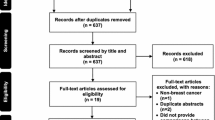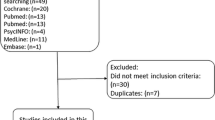Abstract
Toxicity due to treatment causes a negative impact on quality of life in breast cancer survivors. Hot flash symptoms, described as intense sensations of heat, sweating and flushing occur in more than 50 % of breast cancer patients taking tamoxifen. We hypothesized that venlafaxine, a selective-norepinephrine reuptake inhibitor drug, was effective for reducing patient-reported hot flash scores among women treated for breast cancer compared to other non-hormonal treatments. We searched Medline, Scopus, and Cochrane Central Register of Controlled Trials from inception till May 2015 for venlafaxine (75 mg once daily or greater) with non-hormonal comparators for the treatment of hot flashes in female breast cancer patients. The primary outcome was hot flash score (derived from patient-reported hot flash severity and frequency) in randomized controlled trials. Standardized mean differences (SMD) were calculated for each study due to variation in the outcome measures. Heterogeneity was determined using I 2 statistics, and publication bias was assessed using a contour funnel plot and Egger’s tests. Pooled analyses demonstrated that venlafaxine significantly reduced hot flash scores compared to the trial comparators (overall SMD 2.06; 95 % confidence interval (CI) [0.40, 3.72]). There was significant heterogeneity among these studies (I 2 = 98.7 %, P < 0.001). Asymmetry in the contour funnel plot suggests the presence of publication bias and a trend towards small study effects (Egger’s test, P = 0.096). Venlafaxine is efficacious in managing hot flashes among women with breast cancer. This review highlights methodological issues that arise from eligible trials and recommends a collaborative approach in survivorship studies.



Similar content being viewed by others
References
Couzi RJ, Helzisouer KJ, Fetting JH (1995) Prevalence of menopausal symptoms among women with a history of breast cancer and attitudes toward estrogen replacement therapy. J Clin Oncol 13(11):2737–2744
Stan D, Loprinzi CL, Ruddy KJ (2013) Breast cancer survivorship. Hematol Oncol Clin North Am 27(4):805–827
Kronenberg F (1994) Hot flashes: phenomenology, quality of life, and search for treatment options. Exp Gerontol 29(3–4):319–336
Hickey M, Saunders CM, Stuckey BG (2005) Management of menopausal symptoms in patients with breast cancer: an evidence-based approach. Lancet oncol 6(9):687–695
Rance NE, Dacks PA, Mittleman-Smith MA et al (2013) Modulation of body temperature and LH secretion by hypothalamic KNDy (kisspeptin, neurokinin B and dynorphin) neurons: a novel hypothesis on the mechanism of hot fluhes. Front Neuroendocrinol 34(3):211–227
Krause MS, Nakajima ST (2015) Hormonal and nonhormal treatment of vasomotor symptoms. Obstet Gynecol Clin North Am 42(1):163–179
Quella SK, Loprinzi CL, Sloan JA et al (1998) Long term use of megestrol acetate by cancer survivors for the treatment of hot flashes. Cancer 82(9):1784–1788
Goodwin JW, Green SJ, Moinpour CM et al (2008) Phase III randomized placebo-controlled trial of two doses of megestrol acetate as treatment for menopausal symptoms in women with breast cancer: Southwest Oncology Group Study 9626. J Clin Oncol 26(10):1650–1656
Holmberg L, Anderson H, For the HABITS Steering and Data Monitoring Committees (2004) HABITS (hormonal replacement therapy after breast cancer–is it safe?), a randomised comparision: trial stopped. Lancet 363:453–455
Stearns V, Isaacs C, Rowland J et al (2000) A pilot trial assessing the efficacu of paroxetine hydrocholride (Paxil) in controlling hot flashes in breast cancer survivors. Ann Oncol 11:17–22
Pandya KJ, Thummala AR, Griggs JJ et al (2004) Pilot study using gabapentin for tamoxifen-induced hot flashes in women with breast cancer. Breast Cancer Res Treat 83:87–89
Loprinzi CL, Kugler JW, Sloan JA et al (2000) Venlafaxine in management of hot flashes in survivors of breast cancer: a randomised controlled trial. Lancet 356:2059–2063
Weber L, Thacker HL (2014) Paroxetine: a first for selective serotonin reuptake inhibitors—a new use: approved for vasomotor symptoms in postmenopausal women. Womens Health (London Engl) 10(2):147–154
Jin Y, Desta Z, Stearns V et al (2005) CYP2D6 genotype, antidepressant use, and tamoxifen metabolism during adjuvant breast cancer treatment. J Natl Cancer Inst 97(1):30–39
Binkhorst L, Mathijssen RH, van Herk-Sukel MP et al (2013) Unjustified prescribing of CYP2D6 inhibiting SSRIs in women treated with tamoxifen. Breast Cancer Res Treat 139(3):923–929
Boekhout AH, Vincent AD, Dalesio OB et al (2011) Management of hot flashes in patients who have breast cancer with Venladaxine and Clonidine: a randomized, double-blind, placebo-controlled trial. J Clin Oncol 29:3862–3868
Walker EM, Rodriguez AI, Kohn B et al (2010) Acupuncture versus venlafaxine for the management of vasomotor symptoms in patients with hormone receptor-positive breast cancer: a randomized controlled trial. J Clin Oncol 28:634–640
Yamaguchi N, Okajima Y, Fujii T et al (2013) The efficacy of nonestrogenic therapy to hot flashes in cancer patients under hormone manipulation therapy: a systematic review and meta-analysis. J Cancer Res Clin Oncol 139:1701–1707
Juni P, Altman DG, Egger M (2001) Systematic reviews in health care: assessing the quality of controlled clinical trials. BMJ 323:42–46
Hollis S, Campbell F (1999) What is meant by intention to treat analysis? Survey of published randomised controlled trials. BMJ 319:670–674
Sloan JA, Loprinzi CL, Novotny PJ et al (2001) Methodologic lessons learned from hot flash studies. J Clin Oncol 19(23):4280–4290
Stradling C, Chen YF, Russell T et al (2012) The effects of dietary intervention on HIV dyslipidaemia: a systematic review and meta-analysis. PLoS One 7(6):e38121
Carpenter JS, Stomiolo AM, Johns S et al (2007) Randomized, double-blind, placebo-controlled crossover trials of venlafaxine for hot flashes after breast cancer. Oncologist 12:124–135
Buijs C, Mom CH, Willemse PHB, Boezen HM et al (2009) Venlafaxine versus clonidine for the treatment of hot flashes in breast cancer patients: a double-blind, randomized cross-over study. Breast Cancer Res Treat 115:573–580
Elbourne DR, Altman DG, Higgins JPT et al (2002) Meta-analyses involving cross-over trials: methodological issues. Int J Epidemiol 31(1):140–149
Da Costa BR, Rutjes AWS, Johnston BC et al (2012) Methods to convert continuous outcomes into odds ratios of treatment response and numbers needed to treat: meta-epidemiological study. Int J Epidemiol 41(5):1445–1459
Higgins JP, Thompson SG, Deeks JJ et al (2003) Measuring inconsistency in meta-analyses. BMJ 327(7414):557–560
Nüesch E, Trelle S, Reichenbach S et al (2010) Small study effects in meta-analyses of osteoarthritis trials: a meta-epidemiological study. BMJ 341:c3515
Bordeleau L, Pritchard KI, Loprinzi CL et al (2010) Multicenter, randomized, cross-over clinical trial of venlafaxine versus gabapentin for the management of hot flashes in breast cancer survivors. J Clin Oncol 28:5147–5152
Loibl S, Schwedler K, von Minckwitz G et al (2007) Venlafaxine is superior to clonidine as treatment of hot flashes in breast cancer patinets—a double-blind, randomized study. Ann Oncol 18:689–693
Harbord RM, Harris RJ, Sterne JAC (2009) Updated tests for small-study effects in meta-analyses. Stata J 9(2):197–210
Haddad NE, Palesh O (2014) Acupuncture in the treatment of cancer-related psychological symptoms. Integr Cancer Ther 13(5):371–385
Pandya KJ, Raubertas RF, Flynn PJ et al (2000) Oral clonidine in postmenopausal patients with breast cancer experiencing tamoxifen-induced hot flashes: a University of Rochester Cancer Center Community Clinical Oncology Program study. Ann Intern Med 132:788–793
Goldberg RM, Loprinzi CL, O’Fallon JR et al (1994) Transdermal clonidine for ameliorating tamoxifen-induced hot flashes. J Clin Oncol 12:155–158
Kelly CM, Juurlink DN, Gomes T et al (2010) Selective serotonin reuptake inhibitors and breast cancer mortality in women receiving tamoxifen: a population based cohort study. BMJ 8(340):c693
Stearns V, Johnson MD, Rae JM et al (2003) Active tamoxifen metabolite plasma concentrations after coadministration of tamoxifen and the selective serotonin reuptake inhibitor paroxetine. J Natl Cancer Inst 95:1758–1764
Henry NL, Stearns V, Flockhart DA et al (2008) Drug interactions and pharmacogenomics in the treatment of breast cancer and depression. Am J Psychiatry 165:1251–1255
Newton KM, Carpenter JS, Guthrie KA et al (2014) Methods for the design of vasomotor symptom trials: the menopausal strategies: finding lasting answers to symptoms and health network. Menopause 21(1):45–58
Conflict of interest
Dr. Kalesan is employed by PPD (Contract research organization) after this study was completed. This study was not done at PPD. This does not pose a conflict of interest.
Author information
Authors and Affiliations
Corresponding author
Electronic supplementary material
Below is the link to the electronic supplementary material.
Rights and permissions
About this article
Cite this article
Ramaswami, R., Villarreal, M.D., Pitta, D.M. et al. Venlafaxine in management of hot flashes in women with breast cancer: a systematic review and meta-analysis. Breast Cancer Res Treat 152, 231–237 (2015). https://doi.org/10.1007/s10549-015-3465-5
Received:
Accepted:
Published:
Issue Date:
DOI: https://doi.org/10.1007/s10549-015-3465-5




